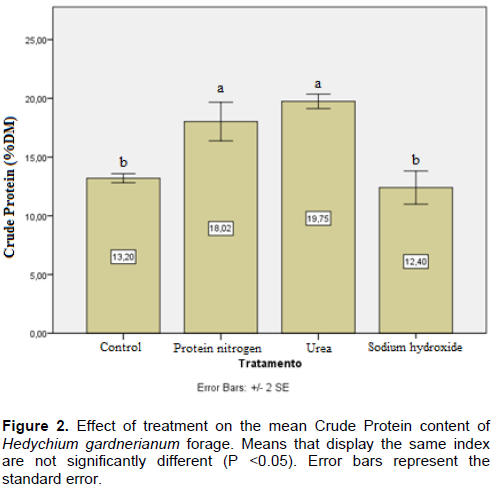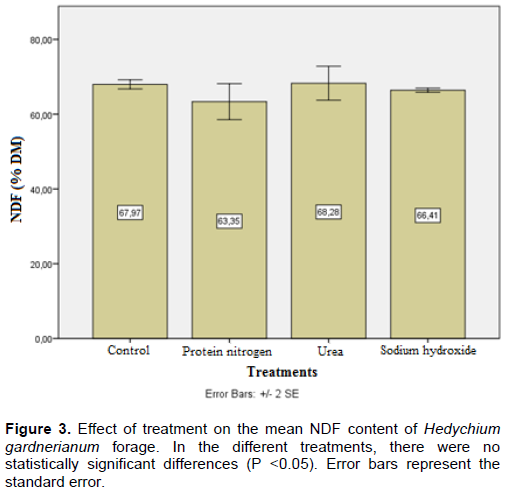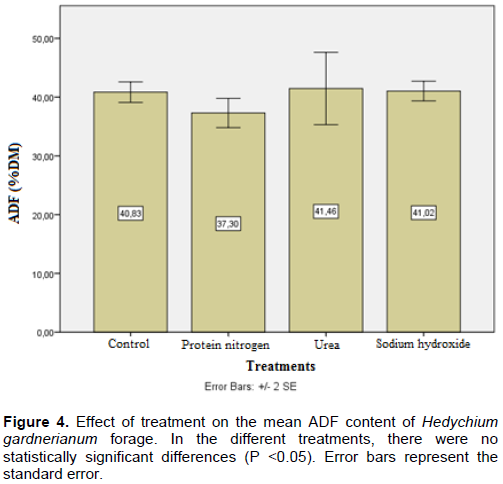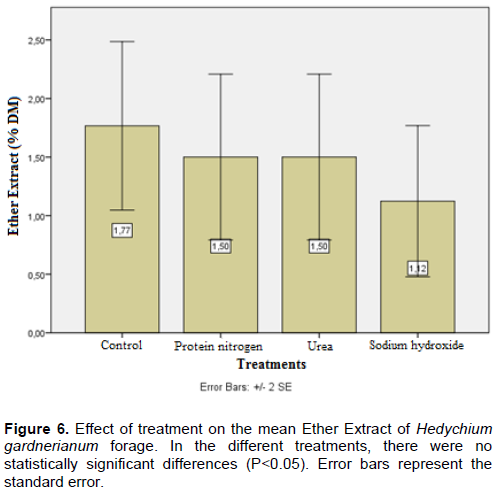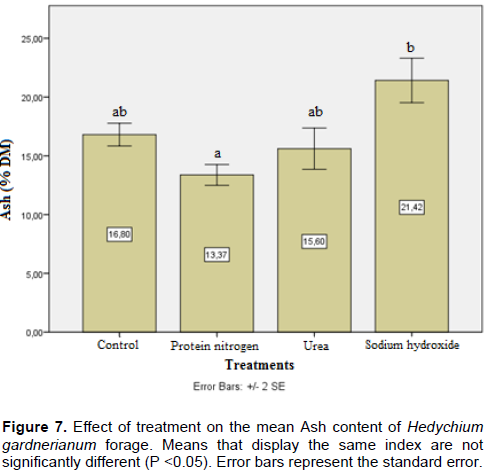ABSTRACT
Animal production in the Azores is conditioned by the cycles of grass production. In a situation when lack of fiber for animal feed occurs, low quality fibrous foods become relevant. For these reasons, Hedychium gardnerianum (ginger lily), a well-known and traditional source of fiber used by Azorean farmers have been studied. The plant material was subjected to treatments with 5% dry matter (DM) with urea, 3% DM with NaOH, and the addition of a nitrogen source (soybean meal) to achieve a content of 18% crude protein in DM, in order to study its nutritional value. The treatment with urea and the addition of a nitrogen source showed a significant (P<0.05) increase in crude protein (CP), while maintaining the neutral detergent fiber (NDF) and acid detergent fiber (ADF) contents, and a variation in the acid detergent lignin (ADL) content. All treatments had a significant effect (P<0.05) on ginger lily DM digestibility. It can be concluded that all the treatments performed had a significant effect on the nutritional value of ginger lily.
Key words: Hedychium gardnerianum, NaOH treatment, urea treatment, roughage.
Animal production in the Azores is conditioned by the cycles of grass production. In the Islands with high altitude impact, for example Pico, S. Jorge and Flores, or in the higher zones of all the islands (more than 300 m of altitude), two lack of grass periods are observed along the year: in summer (namely August and September) and in winter (November, December, January and February). In the lesser altitude dominated Islands and/or lowlands (less than 150 m of altitude), summer, while being much longer, is the only foraging season. In a situation in which there is a lack of fiber for animal feed, low quality fibrous foods become relevant. However, since these foods are of low food nutritional value, low digestibility and low voluntary intake, they do not satisfy the ruminant’s maintenance needs.
The use of unconventional forages has been studied in several parts of the world, as a mean to combat desertification (Correal and Sanchez-Gomes, 1991; Maestre et al., 2009), and for its nutritional value (Topps, 1992; Chakeredza et al., 2007; Meinerz et al., 2011). In the case of the Azores, we intend to value an invasive species, which, although presenting a low nutritional value, has traditionally been used in animal feed.
In recent years, several studies have been carried out on the nutritive valorization of the ginger lily (Hedychium gardnerianum, Sheppard ex Ker-Gawl), of which those carried out by Borba et al. (2015), were emphasized with treatment of the urea content, stating that urea treatment in green forage does not have the same effect as in low quality fibrous forages, especially straw, since the former has a value of crude protein (CP) much superior to that of the latter. The work carried out by Moselhy et al. (2014) who studied the fermentative characteristics of this alternative forage, tested the use of the silage value with different additives, pre-biotic and pro-biotic, with very promising results (Moselhy et al., 2015).
In the work of Borba et al. (2015), the urea treatment was carried out in a green forage, with high water content, with a CP content of 8.05% of DM in non-watertight plastic containers. These constraints may explain the less attractive results found and have laid the groundwork for future trials, in the sense that the treatment should be carried out on dry forage, in watertight containers following one given by Quashie (2014), in addition to testing treatments with sodium hydroxide, to verify if this alkali is more efficient in the degradation of the cell wall of H. gardenerianum than urea.
Several attempts have been made to enhance the nutritive value of the fiber of low quality forages, mainly following two main routes, one via complementation with nitrogen (degradable nitrogenous constituents in the reticulum-rumen to give a nitrogen source to the microbial population and non-degradable nitrogenous constituents in the reticulum-rumen) and another with physical, chemical and biological treatments (Jarrige, 1987).
The main objective of this work is to study the nutritive characteristics of H. gardnerianum, Sheppard ex Ker-Gawl (ginger lily or Kahili ginger-Conteira or Roca-de-Velha in Portuguese) with the addition of a source of nitrogen treated with urea and NaOH.
H. gardenerianum Sheppard ex Ker-Gawl is a rhizomatous herbaceous Zinigigeraceae monocotyledon. This species may reach up to 2.4 m in height with broad, long leaves (20 to 60 cm in length and 8 to 18 cm in width) of bright dark green color. Blooms in late summer and its flowers are light yellow with long red stilettos grouped in dense terminal-shaped spiked inflorescences.
Forage collection and preparation
The current study was conducted in the Animal Nutrition Laboratory, Department of Agricultural Sciences, University of the Azores, located in Angra do Heroísmo, Terceira, Azores, Portugal. The whole plant (leaves and pseudostems) was manually harvested in full vegetative state, in Terceira island, in Cinco Ribeiras at 38°40'29.09" N of latitude and 27°18'20.72" W of longitude. This zone is at an altitude of 97 m above sea level. The plant material was chopped to pieces of approximate 2 to 3 cm of length.
Experimental methodology
The following treatments were applied to plant material dried in a forced air oven at 65°C for 72 h: (i) control; (ii) treated with urea (5% of the dry weight); (iii) treated with NaOH (3% of the dry weight) and (iv) addition of a source of nitrogen (soybean meal) to achieve a content of 18% CP in dry matter (DM). Three replicates were used per treatment, in a total of 12 samples to be analyzed. The urea treatment lasted 4 weeks and was performed in a sealed vessel. The application of urea and NaOH was done by spraying a dilution medium.
Sample contents, in triplicate, were sprayed with the NaOH solution in the proportion of 1 L of solution to 1 kg of dry content. The NaOH treatment had a duration of seven days.
Chemical analysis
Dried samples were then ground through a 1-mm screen using a Retsch mill (GmbH, 5657 HAAN, Germany). Ground samples were analyzed for dry matter (DM, method 930.15), crude protein (CP, method 954.01), ether extract (EE, method 920.39) and total ash (method 942.05) according to the standard methods of AOAC (1995). Briefly, the DM content of forage was determined by placing samples in a forced air oven at 105°C for 24 h. Total ash was evaluated by igniting samples in a muffle furnace at 500°C for 12 h. CP was determined by standard micro-Kjeldahl method using digestion equipment (Kjeldatherm System KT 40, Gerhart Laboratory Instruments, Bonn, Germany) and an automated Kjeltec 2300 Auto-analyzer apparatus for distillation and titration (Foss Electric, Copenhagen, Denmark). Ether extract was measured by refluxing forage samples with petroleum ether in a Soxhlet system (Büchi B-810, Switzerland), while neutral detergent fiber (NDF), acid detergent fiber (ADF) and acid detergent lignin (ADL) were determined according to Goering and Van Soest (1970). Both NDF and ADF were expressed without residual ash.
Dry matter digestibility was determined according to the method of Tilley and Terry (1963) modified by Alexander and McGowan (1966).
Statistical treatment
To evaluate possible differences between treatments on the target variables, analysis of variance (ANOVA) was performed, followed by the Scheffe multiple comparison test whenever significance (P<0.05) was detected.
In the following figures, the results obtained with the treatments done to H. gardenerianum are presented. Figure 1 shows a slight increase in DM with the addition of soybean meal, but there were no significant differences (P<0.05) in the control compared to the three treatments. The nitrogen addition treatments showed a significant (P<0.05) increase in CP content, as would be expected (Figure 2).
The trend of the results verified for the NDF (Figure 3) is similar to those verified for the ADF (Figure 4).
In relation to ADL (Figure 5), a significant decrease of this parameter (P<0.05) was observed with the addition of soybean meal.
Regarding the ether extract (Figure 6), a non-significant decrease (P<0.05) was observed in this parameter, especially for NaOH treatment.
The ash content (Figure 7) of the samples treated with NaOH increases significantly (P<0.05), as expected.
Figure 8 shows significant differences (P<0.05) between the DM digestibility of control and the different treatments, being the NaOH treatment presented the best results.
H. gardnerianum (ginger lily) is a showy ornamental perennial herb with leafy shoots 1.5 to 2 m t all (Wagner et al., 1999). The leaves are alternate, ovate-elliptic, apex acuminate, 20 to 60 cm long and 8 to 18 cm wide. It displaces native plants, forms vast dense colonies and chokes the understory vegetation. It can also block stream edges, altering water flow (GISD, 2017; Silva and Smith, 2004; Silva et al., 2008). H. gardnerianum is native to India and Nepal where it grows on the lower slopes of the Himalayas (1250 m) (Wood et al., 2000). It prefers wet habitats and fertile soils between sea level and 1,700 m (Smith, 1985). Several habitat types have been invaded by these plants, including tropical forests, highland forests, agricultural areas, coastal areas, disturbed sites, natural and planted forests, grasslands, marshes, urban areas and wetlands (PIER, 2004).
H. gardenarium is very abundant in the Azores (Portugal), and is sometimes used as cattle food. However, it is a poor forage of low nutritional value. In order to improve its economic interest regarding animal nutrition, it is important to find a simple and practical method of harvesting this plant as forage and treat it to improve its nutritional value.
Some studies have been carried out with this objective, namely the treatment of green H. with urea (Borba et al., 2015). However, with these tests, there were no statistically significant differences in DM digestibility. It is expected that the treatment would have a better effect on dry forage, as in the treatments of cereal straw.
In this study, there was no significant effect (P<0.05) of protein, urea or sodium hydroxide on DM content, contrary to Granzin and Dryden (2003) and Pereira Filho et al. (2003), who observed a significant drop (P<0.05) in the DM content in a NaOH treatment (Figure 1). On the other hand, in nitrogen treatments, as expected, there were significant differences (P<0.05) in the CP content of the samples, with protein and urea treatments, but NaOH treatment had no effect in this parameter (Figure 2).
With the treatments, a decrease of ether extract was observed (Figure 6), although not significant (P<0.05). Utley et al. (1982) reported a decrease in ether extract content in a treatment of coastal bermuda grass forage with sodium hydroxide, but Moradi et al. (2015) did not observe any variation in this parameter when performing treatments with NaOH and with urea.
A significant (P<0.05) increase was found in ash with the treatment with NaOH (Figure 7), a result similar to that reported by Arisoy (1998) in an essay with straw.
The treatments performed did not have a significant effect on the cell wall of the ginger lily, as can be seen from the results (Figures 3, 4 and 5). On the other hand, all treatments had a significant effect (P<0.05) in the DM digestibility (Figure 8). Other authors observed significant increases in DM digestibility with NaOH treatments (Utley et al., 1982; Arisoy, 1998; Granzin and Dryden, 2003; Pereira Filho et al., 2003), to treatments with urea (Ballet et al., 1997; Candido et al., 1999; Granzin and Dryden, 2003; Hossain et al., 2010; Yadete, 2014). Nianogo et al. (1999) did not find a significant effect of urea treatment on the digestibility of sorghum straws. An explanation for these results may be due to the effect that urea and NaOH have on the breakdown of lignin-carbohydrate cell wall bonds.
In the case of nitrogen treatments, there was a significant enrichment of the CP of the samples, which was reflected in an increase in DM digestibility (P<0.05). This increase in digestibility by nitrogen enrichment may not be the only explanation for the increased digestibility, since untreated forage presents a CP value of 13.20%, which is clearly higher than the 7% reported by Lazzarini et al. (2009) as the minimum limit for normal microbial activity in the rumen.
The treatments with urea and NaOH presented the best DM digestibility, showing no significant differences between treatments (P<0.05), although the NaOH treatment had higher values of DM digestibility.
In our opinion, new treatments must be carried out and this means not only the treatment with urea but also the treatment with sodium hydroxide in variable percentages, with the ultimate goal of finding the right percentage of treatment that will have a significant effect on the degradation of the cell wall of the content, thereby improving its nutritional value.
H. gardenarium (ginger lily) is an infesting plant with great dispersion in the Azores and a threat to the endemic flora of this Archipelago. Ginger lily is a forage commonly used by Azorean farmers in times of grass shortage, especially in summer. Ginger lily is poor forage of low nutritional value, for this reason, the pertinence of finding simple methods for its nutritional valorization was considered.
It can be concluded from this study, which aimed to evaluate the nutritional characteristics of the ginger lily (H. gardnerianum, Sheppard ex Ker-Gawl) with the addition of a source of nitrogen and with the treatments with urea and NaOH, that all treatments had a positive and significant effect (P<0.05) on DM digestibility of the samples. These results open new perspectives for other works that would determine the best concentration of urea and NaOH to be used in the treatments.
The authors have not declared any conflict of interests.
REFERENCES
|
Alexander RH, McGowan M (1966). The routine determination of in vitro digestibility of organic matter in forages. An investigation of the problems associated with continuous large-scale operation. J. Brit. Grassl. Soc. 21(2):140-147.
Crossref
|
|
|
|
AOAC - Association of Official Analytical Chemists (1995). Official Methods of Analysis. 16th ed. Association of Official Analytical Chemists, Virginia, USA.
|
|
|
|
|
Arisoy M (1998). The effect of sodium hydroxide treatment on chemical composition and digestibility of straw. Tr. J. Vet. Anim. Sci. 22:165-170.
|
|
|
|
|
Ballet N, Besle JM, Demarquilly C (1997). Effect of ammonia and urea treatments on digestibility and nitrogen content of dehydrated Lucerne. Anim. Feed Sci. Tech. 67:69-82.
Crossref
|
|
|
|
|
Borba JPR, Maduro Dias CSAM, Rosa HJD, Vouzela CFM, Rego OA, Borba AES (2015). Nutritional valorization of ginger lily forage (Hedychium gardnerianum, Sheppard ex Ker-Gawl) for animal feeding: treatment with urea. Afr. J. Agric. Res. 10:4606-4615.
Crossref
|
|
|
|
|
Candido MJD, Neiva JNM, Pimentel JCM Vasconcelos VR, Sampaio EM, Neto JM (1999). Avaliação do valor nutritivo do bagação de cana-de-açúcar amonizado com uréia. Rev. Bras. Zootec. 280:928-935.
Crossref
|
|
|
|
|
Chakeredza S, Hove L, Akinnifesi FK, Franzel S, Ajayi OC, Sileshi G (2007). Managing fodder trees as a solution to human–livestock food conflicts and their contribution to income generation for smallholder farmers in southern Africa. Natural Resour. Forum 31:286-296.
Crossref
|
|
|
|
|
Correal E, Sanchez-Gomes P (1991). Woody species (trees and shrubs) of multiple value for the arid and semi-arid zones of Northern Mediterranean EEC Countries. Curso de Valorizacion de Forrages y Subproductos Mediterraneos, 13-31 Mayo. CIAEAM. IAMZ. Saragoça. Espanha.
|
|
|
|
|
GISD - Global Invasive Species Database (2017). Species profile: Hedychium gardnerianum. Downloaded from
View on 12-06-2017.
|
|
|
|
|
Goering HK, Van Soest PJ (1970). Forage fiber analyses. Agricultural Handbook nº379, Washington, DC, USA.
|
|
|
|
|
Granzin BC, Dryden G McL (2003). Effects of alkalis, oxidants and urea on the nutritive value of rhodes grass (Chloris gayana cv Callide). Anim. Feed Technol. 103(1):113-122.
Crossref
|
|
|
|
|
Hossain MM, Khan MJ, Akbar MA (2010). Nutritive digestibility and growth of local bull calves as affected by feeding urea and ureases enzyme sources treated rice straw. Bang. J. Anim. Sci. 39: 97-105.
|
|
|
|
|
Jarrige R (1987). Place des fourrages secs dans l'alimentation des herbivores domestiques. In: Les Fourrages Secs, Récolte, Traitement, Utilization. Edit. C. Demarquilly. INRA, Paris pp. 13-22.
|
|
|
|
|
Lazzarini I, Detmann E, Sampaio CB, Paulino MF, Valadares Filho SC, Souza MA, Oliveira FA (2009). Dinâmicas de trânsito e degradação da fibra em detergente neutro em bovinos alimentados com forragem tropical de baixa qualidade e compostos nitrogenados. Arq. Bras. Med. Vet. Zootec. 61(3):635-647.
Crossref
|
|
|
|
|
Maestre FT, Bowker MA, Puche MD, Belén Hinojosa M, Martínez I, García-Palacios P, Castillo AP, Soliveres S, Luzuriaga AL, Sánchez AM. (2009). Shrub encroachment can reverse desertification in semi-arid Mediterranean grasslands. Ecol. Letters 12:930-941.
Crossref
|
|
|
|
|
Meinerz GR, Olivo CJ, Fontaneli RS, Agnolin CA, Fontaneli RS, Horst T, Viégas J, Bem CM (2011). Valor nutritivo da forragem de genótipos de cereais de inverno de duplo Propósito. Rural Bras. Zootec. 40:1173-1180.
Crossref
|
|
|
|
|
Moradi M, Afzalzadeh A, Behgar M, Norouzian MA (2015). Effects of electron beam, NaOh and urea on chemical composition, phenolic compounds, in situ ruminal degradation and in vitro gas production kinetics of pistachio by-products. Vet. Res. Forum 6:111-117.
|
|
|
|
|
Moselhy MA, Borba JP, Borba AES (2015). Improving the nutritive value, in vitro digestibility and aerobic stability of Hedychium gardnerianum silage through application of additives at ensiling time. Anim. Feed Sci. Technol. 206:8-18.
Crossref
|
|
|
|
|
Moselhy MA, Nunes HP, Borba AES (2014). Effect of replacement of ordinary ruminant feed with Hedychium gardnerianum or Pittosporum undulatum on in vitro rumen fermentation characteristics. Int. J. Adv. Res. 2:91-104.
|
|
|
|
|
Nianogo AJ, Louis SL, Solaiman S, Ouédraogo CL, Siaway A (1999). Effect of urea treatment on digestibility and utilization of sorghum straw. Biotechnol. Agron. Soc. Environ. 3:78-85.
|
|
|
|
|
Pereira Filho JM, Vieira EL, Silva AMA, Cezar MF, Amorim FU (2003). Effect of sodium hydroxide treatment on fiber fraction, digestibility and tannin of Jurema-preta hay (Mimosa tenuiflora. Wild). Rural Bras. Zootec. 32:70-76.
Crossref
|
|
|
|
|
PIER - Pacific Island Ecosystems at Risk (2004). Pacific Island ecosystems at risk database,
<View> on 12-06-2017
|
|
|
|
|
Quashie BS (2014). Studies on various treatment conditions affecting urea-ammoniated rice straw in Ghana. University of Ghanna, Balme Library, Accra, Ghana.
|
|
|
|
|
Silva L, Ojeda EL, Rodrigues JLL (2008). Invasiva terrestrial flora and fauna of Macaronesia. TOP 100 nos Açores, Madeira e Canárias. ARENA, Ponta Delgada, Açores, Portugal.
|
|
|
|
|
Silva L, Smith CW (2004). A caracterization of the non-indigenous flora of the azores Archipélago. Biological Invasions, 6:193-204.
Crossref
|
|
|
|
|
Smith CW (1985). Impact of alien plants on Hawaii's native biota. In: Stone CP, Scott JM, eds. Hawaii's Terrestrial Ecosystems: Preservation and Management. Honolulu, Hawaii, USA: University of Hawaii Press pp. 180-250.
|
|
|
|
|
Tilley JMA, Terry RA (1963). A two-stage technique for the in vitro digestion of forage crops. J. Br. Grassl. Soc. 18(2):104-111.
Crossref
|
|
|
|
|
Topps JH (1992). Potential, composition and use of legume shrubs and trees as fodders for livestock in the tropics. J. Agric. Sci. Cambridge 118:1-8.
Crossref
|
|
|
|
|
Utley PR, Hellwig RE, McCormick WC, Butler JL (1982). The effect of treating Coastal bermudagrass pellets with sodium hydroxide and monensin on forage utilization and growth of beef calves. Can. J. Anim. Sci. 62:499-505.
Crossref
|
|
|
|
|
Wagner WL, Herbst DR, Sohmer SH (1999). Colocasia. In: Manual of the Flowering Plants of Hawaii. University of Hawaii Press, Honolulu, Hawai'i pp. 1356-1357.
|
|
|
|
|
Wood TH, Whitten WM, Williams NH (2000). Phylogengy of Hedychium and related genera (Zingiberaceae) based on ITS sequence data', Edinburgh J. Bot. 57(2):261-270.
Crossref
|
|
|
|
|
Yadete GK (2014). Effect of wheat straw urea treatment and Leucaena leucocephala foliage hay supplementation on intake, digestibility, nitrogen balance and growth lambs. Int. J. Livest. Prod. 6:88-96.
|
|

